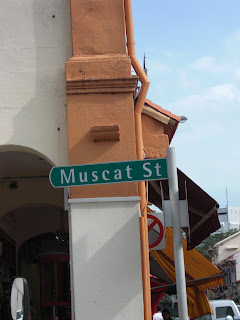What was really fascinating for me was the fact that the Sultan Mosque has soya sauce bottles beneath one of its minaret for preservation purposes. Even after having visited it for prayers before, I have not noticed that before! As a national monument, the mosque had taken measures to teach tourists about its history. When we visited, I noticed boards with the mosque’s historical information on them. There were also pamphlets in Japanese for the Japanese tourists. On some days, there are tour guides for tourists as well. As a muslim, I feel quite ashamed that I probably know lesser than these tourists.
While waiting for Fitri, the call to afternoon prayer was made and so Hamizah, Afroza and I headed to the Sultan Mosque to pray. Xiang Lin was there too and she followed us to the ablution area where we cleansed ourselves. I felt it was necessary for me to explain to her what we were doing because she was still foreign to our practice. It then dawned on me it is my job to have a clear insight on the history of a subject in order to explain it well to her. Therefore, this heritage trail has somewhat made me come to senses that I cannot be so ignorant about our history.
We started the trail with our first stop, the Malay Heritage Centre. It was a fruitful experience especially when we went into the Malay Museum. I learnt about the history of my grandparents, as they were from the island Bawean which most probably meant that they were ‘Orang Laut’. There were also a few Qurans on display and I could sense a strong connection between Islam and the Malays then. Kampong Glam was also the point where pilgrims going to Mecca for the Hajj would meet before setting off on large steam ships.
Conservation of some of the buildings in the trail has taken place. For example, the Sultan Mosque and Gedung Kuning still stand today. However, the latter is now no longer a mansion but a restaurant, Tapak Sireh. But it remains bright yellow, hence, we could easily locate it during the trail. The compounds of the Sultan Palace are now used as a tourists’ attraction, with the palace being a museum. I was actually astounded when I found out we were in the palace itself. The Pondok Java and the Lee Hoy Blacksmith Shop, on the other hand, are no longer standing. The Pondok Java was deemed structurally unsafe hence brought down. We believe that a restaurant stands in the place of the Lee Hoy Blacksmith Shop today. (this is just a conjecture)
I am sure that to every heritage trail, there is a unique history waiting to be uncovered. Some of the structures are conserved so that the future generation can have a chance to relook and try to get a feel of what it felt like in its heyday. At first, when I found out that my group got the Kampung Glam trail, I felt a tad disappointed because I wished I had gotten a trail that was not related to my own cultural roots, like Little India or Chinatown. But at the end of the day, I learnt that I am actually quite clueless about my own heritage.






































